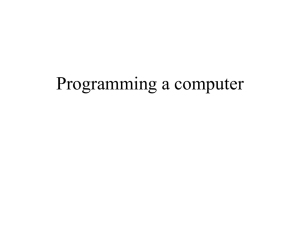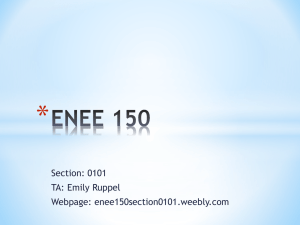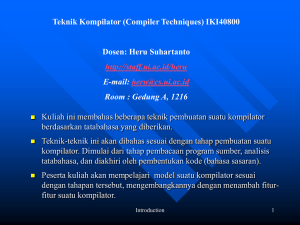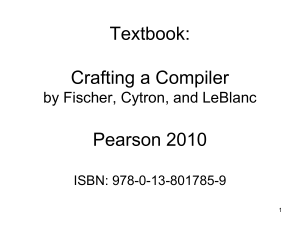Breaking SIMD Shackles with an Exposed Flexible Microarchitecture
advertisement
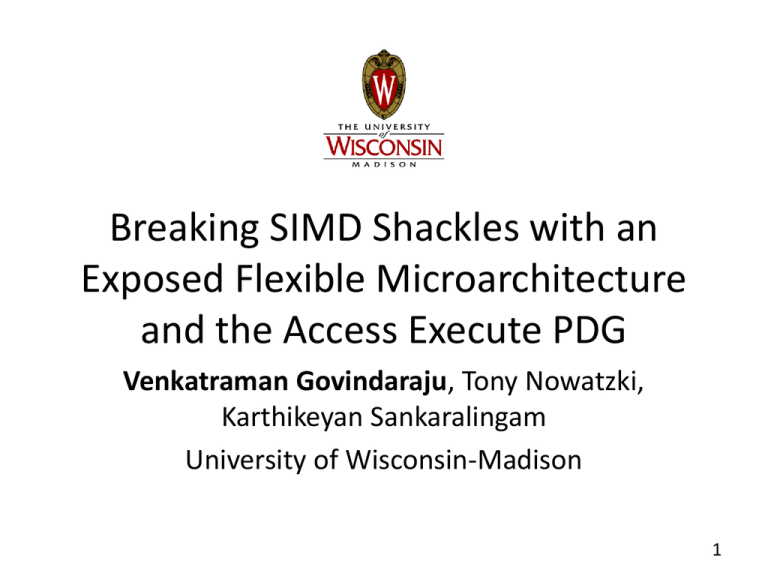
Breaking SIMD Shackles with an
Exposed Flexible Microarchitecture
and the Access Execute PDG
Venkatraman Govindaraju, Tony Nowatzki,
Karthikeyan Sankaralingam
University of Wisconsin-Madison
1
Motivation
SIMD (Single Instruction Multiple Data)
Exploits data level parallelism
Great for performance and energy
How can
weSSE/AVX,
broaden
the
scope
Examples:
X86’s
ARM’s
NEON
of
vectorization?
Programming for SIMD
Assembly or compiler intrinsics
Preferred: Auto-vectorization
Compilers fail to auto-vectorize on most cases*
* S. Maleki et al. An evaluation of vectorizing compilers. In PACT 2011
2
An Example
//Needleman Wunsch
int a[],b[]; //initialize
for(int i =1; i < NCOLS; ++i) {
for(int j = 1; j < NROWS; ++j) {
a[i][j]=max(a[i-1][j-1]+b[i][j],
a[i-1][j],
a[i][j-1]);
}
}
Array a[][]
Compilers do not map this code to SIMD unit
Outer Iterations
Use resultare
of
dependent,
too iteration
previous
Dependence
Chain
3
SIMD Shackles: Its Interface to
Compiler
Memory/Vector Register File
Fixed parallel datapath
No control flow
Fixed mem. interface
4
Our Solution
Flexible Microarchitecture (DySER)
Memory/Vector Register File
Configurable datapath
Control flow support
Flexible mem. interface
5
Our Solution
Flexible Microarchitecture (DySER)
Expose aMemory/Vector
flexible
Register File
microarchitecture to
compiler
Capture theConfigurable
complexity datapath
with AEPDG, a variant
Control
flow
support
of PDG
Design and Implement
a compiler with AEPDG
Flexible Mem. Interface
6
Executive Summary
Identify microarchitecture techniques required to
tackle the challenges with vectorization
Develop AEPDG, a variant of program dependence
graph to model the flexible microarchitecture.
Design and implement compiler optimizations with
AEDPG.
Demonstrate how our solution broadens the scope of
SIMD
Evaluate on throughput benchmarks and show that our
solution outperforms ICC on SSE/AVX by 1.8x.
7
Outline
Introduction
Flexible Architecture: DySER
Access Execute PDG (AEPDG)
Compiler Design and Optimizations
Evaluation
Conclusion
8
DySER Overview
Fetch
I$
Decode Execute
Decode
[HPCA 2011]
Memory WriteBack
Exec
Units
Register
File
D$
DySER
• Circuit-switched array of functional units
• Integrated to processor pipeline
• Dynamically creates specialized datapath
9
Flexible Microarchitecture:
Configurable Datapath
Configure switches and
functional units to create
different datapath
S
×S
Can specialize datapath
For ILP
For DLP
Allows the compiler to
use DySER to accelerate
variety of computation
patterns
S
×
S
S
S
S
S
+
S
S
+
?:
S
S
×
+>
&
+
S
S
S
S
SumMul-Accumulate
of Abs.
Differences
3x3
Convolution
10
Flexible Microarchitecture:
Control Flow Mapping
Predication
Predicates the output
A metabit in datapath
propagates the validity
of the data
S
in0 V
1
0 S in1 SV
>
S
S
S
PHI
Pred.
S
S
+
S
S
S
S
φ
“Select” function unit
S
S
S
S
(PHI functions)
Native control flow mapping allows
in1 V
1
Out
Selects
valid input
andDySER to accelerate code
compilers
to use
forwards aswith
its output
arbitrary control-flow
11
Flexible Microarchitecture:
Decoupled Access/Execute Model
Memory access
instructions execute in
processor pipeline
Address Calculation,
Loads, and Stores
Configure DySER
Send Data to DySER
Recv Data from DySER
Computation executes in
DySER
Config
____________
____________
-
+
x
+
+
____________
____________
-
+
x
+
+
____________
Processor
DySER
12
Flexible Microarchitecture:
Decoupled Access/Execute Model
Processor sends data to
DySER through its input
FIFOs (input ports)
DySER computes in data flow
fashion
Processor receives data from
DySER through its output
FIFOs (output ports)
IP0
IP1
IP2
IP3
Input
FIFO
S
S
S
S
S
S
S
S
S
S
S
S
Decoupled Access/Execute model allows
S in different
S
S
S
DySER to consume data
order
than how it is stored
OP0
OP1
OP2
OP3
Output
FIFO
13
Flexible Microarchitecture:
Flexible Vector Interface
Memory/
Vector register
0
1
2
3
4
5
6
7
“Vector Port Mapping”
IP0
3
2
21
0
IP1
IP2
IP3
3
1
2
3
S
S
S
S
Flexible vector
interface
allows
compiler
to
use DySER to code with different memory
S
S
S
access
patterns
(eg.S Strided)
14
Outline
Introduction
Flexible Architecture: DySER
Access Execute PDG
Compiler Design and Optimizations
Evaluation
Conclusion
15
Access Execute Program Dependence
Graph (AEPDG)
A variant of PDG
Edges represent both data and
control dependence
for (i = 0; i < N; ++i)
if b[i] < 0:
a = b[i] + 5;
else:
a = b[i] - 5;
b[i]=a;
b+i
Explicitly partitioned into accessPDG and execute-PDG subgraph
Edges between access and
execute-PDG augmented with
temporal information
LD
<
-
+
φ
ST
16
AEPDG and Flexible Interface
Original AEPDG
a[i+3]
a[i]
a[i+1]
a[i+2]
a[i]
1
×
×
+
×
Vector Map Generation
(Load/Store Coalescing)
Unrolled AEPDG
a[i+4]
a[i+2]
a[i+1]
0
0
×
a[i+5]
1
×
0
×
1
Vector Port (for a[])
0 1 2 3 4 5 6 7
P0
x P1
x P2
x P0
x P1
x P2
x x x
Vector Port Map
P0
P1
P2
3
0
4
1
5
2
×
×
×
P3
+
+
out[i]
+
0
out[i]
1
out[i+1]
Each edge on the interface knows its order
17
AEPDG and Flexible Interface
Original AEPDG
Unrolled AEPDG
Vector Map Generation
Vector Port (for a[])
a[i]
a[i+1]
×
×
+
a[i+2]
×
0 1 2 3 4 5 6 7
a[i:i+5]
×
×
×
P0
x P1
x P2
x P0
x P1
P0
x P2
P1
x x x
Vector Port Map
P0
P1
P2
4
0
5
1
6
2
×
×
×
P3
+
+
out[i]
+
0
out[i]
1
out[i+1]
Each edge on the interface knows its order
18
Outline
Introduction
Flexible Architecture: DySER
Access Execute PDG
Compiler Design and Optimizations
Evaluation
Conclusion
19
Compilation Tasks
Identify loops to specialize
Construct AEPDG
Access PDG
Execute PDG
Perform Optimizations
Vectorization, if possible
Application
Region Identification
Partitioning
Access
Code
Execute
Code
Optimization
Schedule
Execute PDG to DySER
Access PDG to Core
Scheduling
Core
DySER
aaa
20
Small loops
We can again leverage loop properties.
Simply unroll the loop further, “Cloning” the region
Before
Input
FIFO
a[3]
a[2]
a[1]
a[0]
b[3]
b[2]
b[1]
b[0]
×
Execute
Region
Output
FIFO
After
+
c[3]
c[2]
c[1]
c[0]
a[2]
a[0]
Also Uses
Flexible I/O
b[2]
b[0]
×
a[3]
a[1]
b[3]
b[1]
×
+
+
c[0]
c[2]
c[1]
c[3]
21
Large Loops: Sub-graph Matching
Subgraph Matching
Find Identical computations, split them out
Region Splitting
Configure multiple regions, quickly switch between them
Large Region
Subgraph Matching
Region Virtualization
22
Loop Dependence
//Needleman Wunsch
int a[],b[]; //initialize
a[i-1][j-1]
for(int i =1; i < NCOLS; ++i) {
for(int j = 1; j < NROWS; ++j) {
a[i][j]=max(a[i-1][j-1]+b[i][j],
a[i-1][j],
a[i][j-1])
}
}
Outer Iterations
Use resultare
of
dependent,
too iteration
previous
Dependence
Chain
Array a[]
a[i-1][j]
a[i][j-1]
+
max
max
a[i-1][j]
a[i][j]
a[i-1][j+1]
+
Vectorizable!
max
max
a[i][j+1]
23
Outline
Introduction
Flexible Architecture: DySER
Access Execute PDG
Compiler Design and Optimizations
Evaluation
Conclusion
24
Evaluation Methodology
Implementation
Leverages LLVM compilation framework
Constructs AEPDG from LLVM-IR
Generates binary for x86, SPARC
Benchmarks
Throughput kernels
Parboil benchmarks
Simulation framework
Gem5 + DySER
Evaluated DySER with a 4-wide out-of-order core
Compared ICC auto-vectorizer to DySER compiler
25
SSE/AVX Vs. DySER
13x
5
When
WithDLP
control
readily
intensive
available,
code,
both
SIMDDySER
and DySER
perform
perform
betterbetter
DySER bottlenecked
by FDIV/FSQRT units
3
SSE
2
AVX
DySER
1
HM
NEEDLE
NNW
TPACF
STENCIL
SPMV
MRI-Q
MM
LBM
KMEANS
FFT
CutCP
VR
TREESEARCH
RADAR
NBODY
MERGE
0
CONV
Speedup Over SSE
4
DySER performs on average 1.8x better than SSE/AVX
26
1
Outer Loop
Transformations
0.8
Different
strategy for
Reduction
Constant
Table
Lookup
0.6
0.4
Compiler
0.2
HM
CutCP
FFT
KMEANS
LBM
MM
MRI-Q
SPMV
STENCIL
TPACF
NNW
NEEDLE
0
CONV
MERGE
NBODY
RADAR
TREESEARCH
VR
Relative to programmer optimized
Programmer Optimized vs. Compiler Optimized
Compiler generated code’s slowdown is only 30%
27
Conclusion
Broke the “SIMD Shackles” with flexible
microarchitecture
Managed the complexity of the microarchitecture
interface with AEPDG
Compilers build using AEPDG can broaden the
scope of SIMD
Must rethink accelerators and their interface to
compiler
Incremental changes to accelerators leads to
diminishing returns
28
Questions?
DySER compiler available at
http://research.cs.wisc.edu/vertical/dyser-compiler
29

